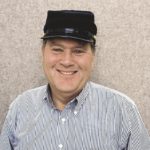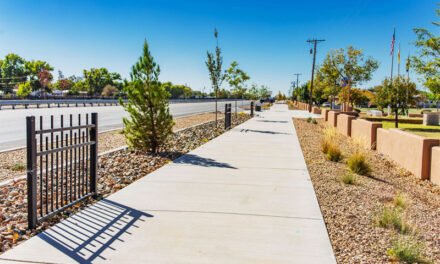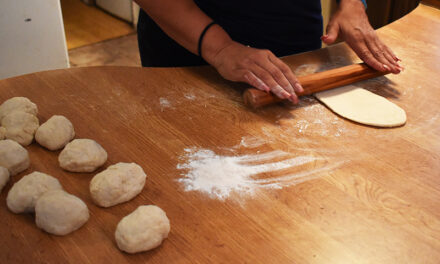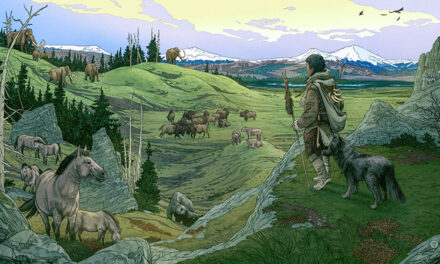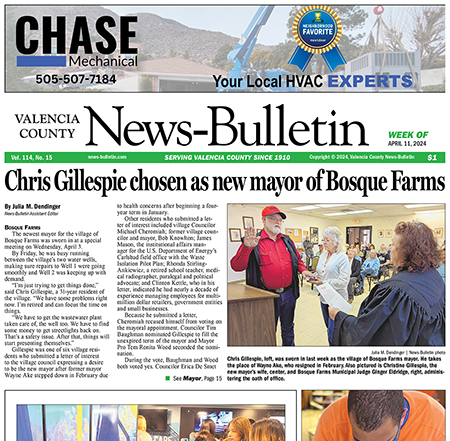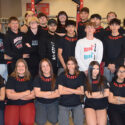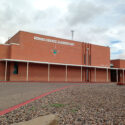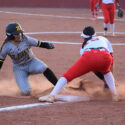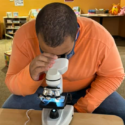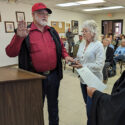
Photo courtesy of the Huning family
The Huning brothers—Louis Bismark, Franz, Carl, and Henry
(La Historia del Rio Abajo is a regular column about Valencia County history written by members of the Valencia County Historical Society. The author of this month’s column is John Taylor, a retired engineer from Sandia National Laboratories and board member of the Valencia County Historical Society. He is the author or co-author of twenty books on New Mexico history, including “Murder, Mystery, and Mayhem in the Rio Abajo,” “A River Runs through Us,” “Tragic Trails and Enchanted Journeys,” “Mountains, Mesas, and Memories,” and “Years Gone by in the Rio Abajo,” all co-edited with Dr. Richard Melzer. Opinions expressed in this and all columns of La Historia del Rio Abajo are the author’s only and not necessarily those of the Valencia County Historical Society or any other group or individual.)
There are many historic buildings in Los Lunas — the Luna Mansion, San Antonio Catholic Church, and Teofilo’s Restaurante, to mention just a few. However, the Huning House on Main Street is one of the most unique.
Built sometime in the mid-1700s, the Huning House may be the oldest continuously occupied building in Los Lunas.
Four German brothers
The influx of Europeans into the Rio Abajo in the middle and late 19th century is well documented. Archbishop Lamy brought numerous French priests to New Mexico in the 1850s to take the place of Mexican priests, including posting Father Jean Baptiste Ralliere to Tomé; German merchants, such as John Becker, Oscar Goebel, Julius Freudenthal and Frederick Scholle opened various retail businesses in Belen; and German Jewish merchants, such as Moses Sachs and Simon Neustadt were active in Los Lunas.
Franz and Carl (sometimes referred to as Karl or Charles) Huning, two of 13 siblings, were born in Melle, Germany, in the northern province of Hanover, where their father, Johann Frederick Huning, was a well-to-do farmer.
The two brothers emigrated to the United States in 1848, ostensibly to avoid conscription into the German army. They eventually came to New Mexico along the Santa Fe Trail, hired on as bullwhackers on a wagon train carrying supplies for the Army. Although the brothers were originally on their way to the California gold fields, they liked what they found in New Mexico and elected to stay.
Both brothers had experience clerking in stores in Germany, and they easily found similar jobs in various stores in San Miguel del Vado, Santa Fe, and Albuquerque.
Ehrhardt Franz, who was a cousin of Belen merchant, John Becker, (and who may also have been a cousin of the Hunings) came to the United States in August 1854, and met Franz Huning in St. Louis in 1859, probably while the latter was on a buying trip for the store for which he was clerking. Huning suggested to Franz that he should move to New Mexico and that Los Lunas would be a good destination, since the first Anglo merchants in the area, Moses Sachs and Nathanial Macrae, had recently gone out of business.
In April 1861, two more Huning brothers, Louis and Henry, arrived in New York and, within a month, had joined their brothers in New Mexico. Franz Huning took a job as a clerk in an Albuquerque store owned by Simon Rosenstein in 1856 and would remain in the city until his death in 1905.
During his time in Albuquerque, he built one of the most famous landmarks in the city, the so-called Huning Castle at 15th Street and Central Avenue. Although he stayed in Albuquerque, Franz remained a partner with his brothers, Henry and Louis, as they developed their mercantile business in the Rio Abajo.
Carl worked as a clerk for his brother, Louis, and Ehrhardt Franz in Huning, Franz and Company’s Los Lunas store. According to tax records, the partners may also have used part of the house as a hotel.
In the aftermath of the 1862 Confederate invasion of New Mexico, while Franz Huning was on another buying trip in St. Louis, Carl was arrested and accused of being a Confederate collaborator. Although he was quickly freed when Franz returned, he had enough of New Mexico and returned to Germany.
Building a mercantile empire in the Rio Abajo
In 1865, Louis purchased a mercantile store in Belen from Julius Freudenthal. Then, with Henry, he purchased another store in Sabinal. Henry stayed on as a partner in the stores while also establishing himself as a retail liquor salesman in Cubero.
Ehrhardt Franz had taken Franz Huning’s advice and moved to Los Lunas, purchasing land in the plaza vieja (old plaza — the center of the small village) from Jose Rafael Maestas (sometimes spelled Mestas), an uncle of Don Antonio Jose Luna, the so-called “father of Los Lunas.”
The Maestas property included a terrone house, probably built in the mid-1700s. Originally four rooms, with large vigas supporting a flat roof, it had been expanded to the north and east over the years into a 12-room structure surrounding a central placita. Each of the rooms was large, measuring 18-by-20-feet, with pine floors and deep-set windows.
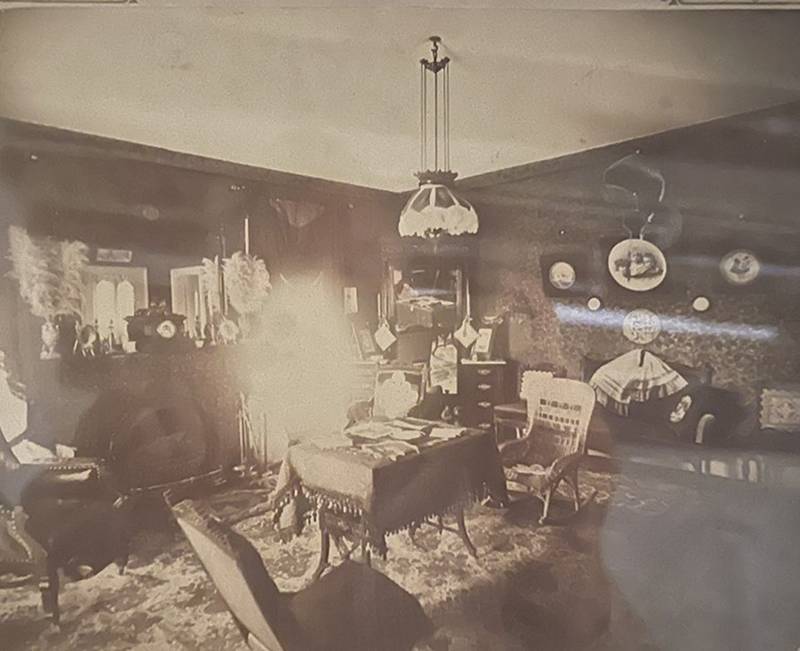
Huning house living room
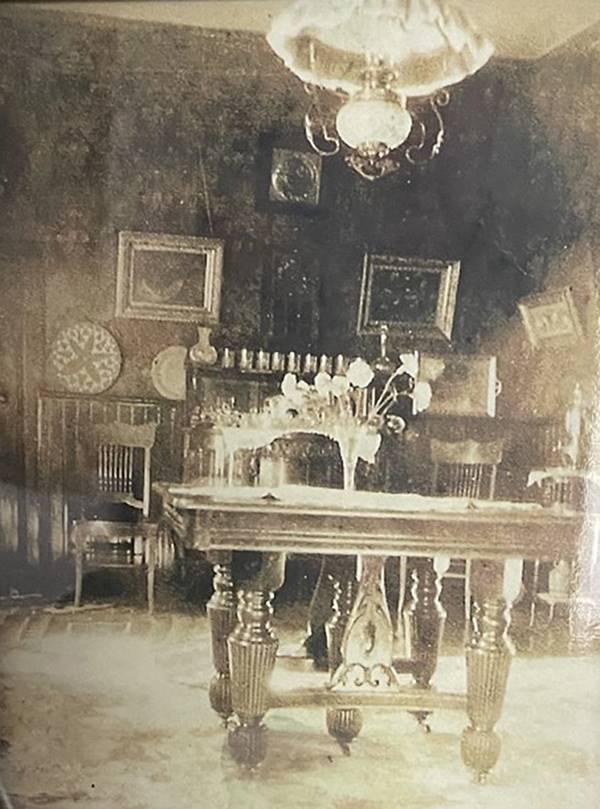
Huning house dining room
Some rooms had a door opening into the placita, and doors on either end opened into the adjoining room. In 1784, the house was appraised at 260 pesos (as much as $560,000 in today’s dollars), a considerable sum for that period.
Franz added a storefront on the east side of the home and started his mercantile business. A walkway (which still exists on the north side of the store) led to the front door to the home, which opened into an entryway with doors to the placita and both wings of the home. There were also outbuildings on the property, including servants quarters, a barn and an ice house
Louis joined the business with Ehrhardt Franz in 1865, and he and Henry bought the store from Franz in 1871 when Franz decided to move back to St. Louis. The store was opened as L. H. Huning & Company. The store sold yard goods, needles, thread, pots and pans, hardware, whiskey, saddles, tack and food stuffs that could not be locally raised. The letterhead for invoices from the company read, “L. H. Huning & Co., Drugs, Family Groceries, Fancy goods, Country Produce, Shoes, Notions, &c.”
The brothers purchased their inventory from a wide variety of suppliers all across the country. Sugar came from the California Sugar Factory in San Francisco; Platt and Thornburg Paint and Glass Company in St. Louis supplied lamps, lanterns, lantern filaments and bottle caps; and Reid, Murdoch, & Fisher, from Chicago, provided syrup, French sardines, and potted meats, among other food products.
The brothers also patronized a number of Albuquerque wholesalers, including Albuquerque Foundry & Machine Company and J. C. Baldridge Company. Until the railroad arrived in 1880, goods were shipped by wagon train along the Santa Fe Trail to Santa Fe and then on to Los Lunas by wagon.
The Huning brothers also contracted with the Department of the Army to supply food, forage and other materials to forts Craig, Marcy, McCrae, Apache and Wingate. From 1871 to 1884, the brothers received a total of $9.8 million (in 2015 dollars) from their federal contracts.
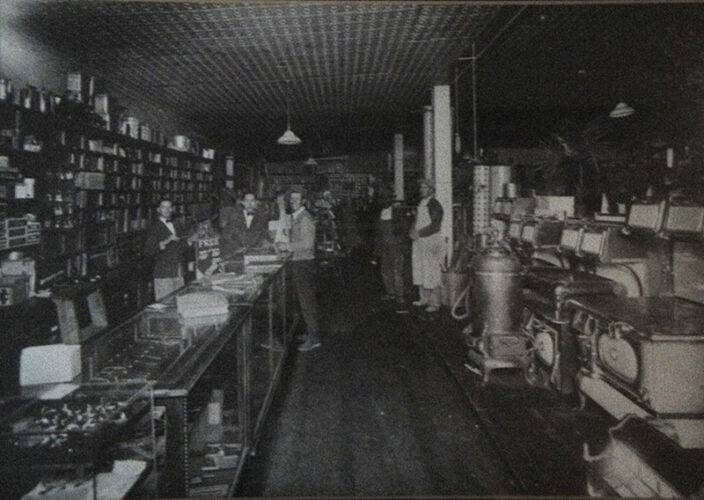
An interior view of the Huning mercantile store
Foodstuffs and hay were also purchased from local farmers, and the brothers built the Champion Mill, a state-of-the-art grist mill in Los Chaves. Rico Gonzales has noted that this mill “revolutionized the economy of Valencia County by introducing a system of exchange value and market relationships that superseded the previous ‘survival-based’ agricultural economy.”
One of the revolutionary aspects of the mill was a dedicated telegraph line between the store and the mill so that Louis could keep tabs on the mill operation. Unfortunately, the mill burned down on June 26, 1898, surmised to have been the result of an “incendiary [arsonist] who failed to leave his address.”
The brothers also entered the sheep industry and purchased land as far west as Arizona. In 1878, Louis owned 80,000 head of sheep.
The Los Lunas store, which was attached to the home, had 18-inch adobe walls and was about 100 feet square. Partitions on the inside divided the interior into departments. The front door opened to the east onto a portal supported by wooden pillars, and a platform scale for weighing wagons of hay, wool, or grain was installed south of the building.
When Louis’s new wife, Henrika Busch Huning, arrived in Los Lunas in 1876, the exterior of the house was pebble-dashed grey plaster. The interior walls were whitewashed, and the doors and window frames were painted a dull red. Woodwork in the kitchen was painted blue. She soon had all the woodwork painted brown or white and added brown panel wainscoting to the dining room. The wainscoting, installed by Henrika, is still in the room where it was originally installed.
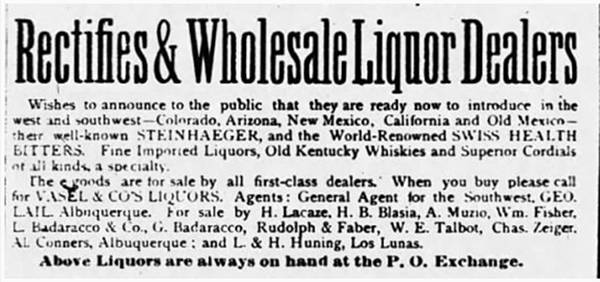
Albuquerque Journal,1886
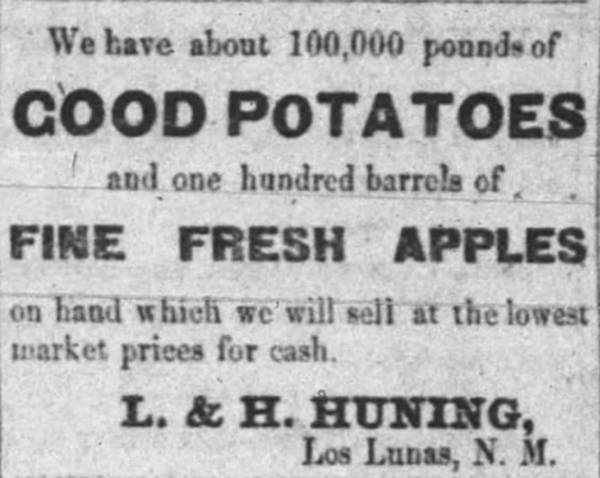
Socorro Chieftan, 1881
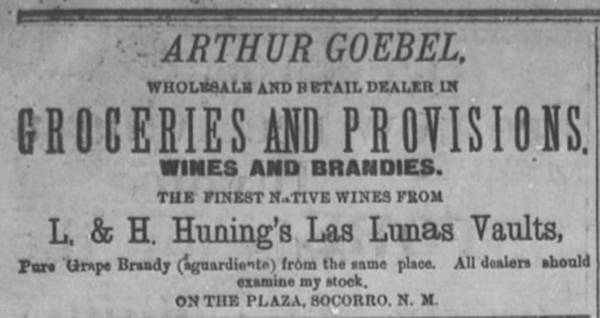
Santa Fe New Mexican, 1888 (note the incorrect spelling of Los Lunas)
Challenging times
In 1888, the two brothers parted company under what some have described as “stormy” conditions. Henry, who had been living in Arizona since 1872, filed a lawsuit against his brother, alleging that Louis had secretly withdrawn money from their corporate account without consulting him. The lawsuit further contended that “for the past two years many vexations and irreconcilable differences have arisen and now exist.”
Although the legal outcome of the suit is unclear, when the dust settled, Louis kept the store and all of the New Mexico land and ranch holdings, and Henry took over the Arizona properties. Part of the settlement also included a cash payment of $50,000 from Louis to Henry.
When he filed the suit, Henry, who had acquired a reputation of something as a playboy with a taste for rich things as well as women (some have suggested that he was directly responsible or at least took responsibility for up to 18 children), may not have been aware of the financial challenges associated with the store.
A confluence of events hit New Mexico and Louis hard in the last decades of the 19th century. A large portion of the store’s income had come from federal contracts, particularly during the Indian Wars. However, as the Indian Wars ended and troops were withdrawn from the territory, the government terminated many of its contracts.
Secondly, a significant drought bedeviled the Southwest from 1873 to 1883, and the lush Rio Puerco grazing lands, which Louis had leased, could no longer support his large herd of cattle. The financial panic of 1893 caused cattle prices to plummet. These events forced many of L & H Huning’s customers to buy on credit, which they were frequently unable to repay.
Often they traded land or goods to cover their debts. This made Louis land and material rich but cash poor, particularly after the $50,000 payment to Henry, and he had to scramble to keep the business afloat. Finally, in 1893, he was forced to sell most of his land and close the Los Lunas store. His profitable flour mill burned down in 1898, and he died in 1901, still trying mightily to erase all of his debts.
A family legend says the “jewel of the family properties” was a vacation home on the New Mexico-Arizona border. As the story goes, when the legal settlement was proceeding, the brothers decided to determine ownership by a card game in which the low card would win. Henry cut the cards and “showed low” with the two of clubs.
The location was subsequently known as Show Low! Arizona historian Anthony Cooley notes that, while the story of the card game appears to be true, it actually happened between two Arizona ranchers, who may have been employees or friends of the Hunings, but were almost certainly not the Huning brothers themselves.
In fact, Henry’s lifestyle and behavior were so problematic that Louis’ wife, Henrika, prohibited the mention of Henry’s name in the house, and that “prohibition” continued for at least two subsequent generations!
Despite this apparent schism in the family, Louis did stand up for Henry in several legal actions filed against him in Arizona. These legal challenges and some of the results of his playboy lifestyle led Henry to move to Santa Barbara, Calif., in 1910. He died in the Huning Castle while on a business trip to Albuquerque in March 1922, and his body was returned to Santa Barbara for burial.
We will follow the history of the Huning House to the present in next week’s column.
